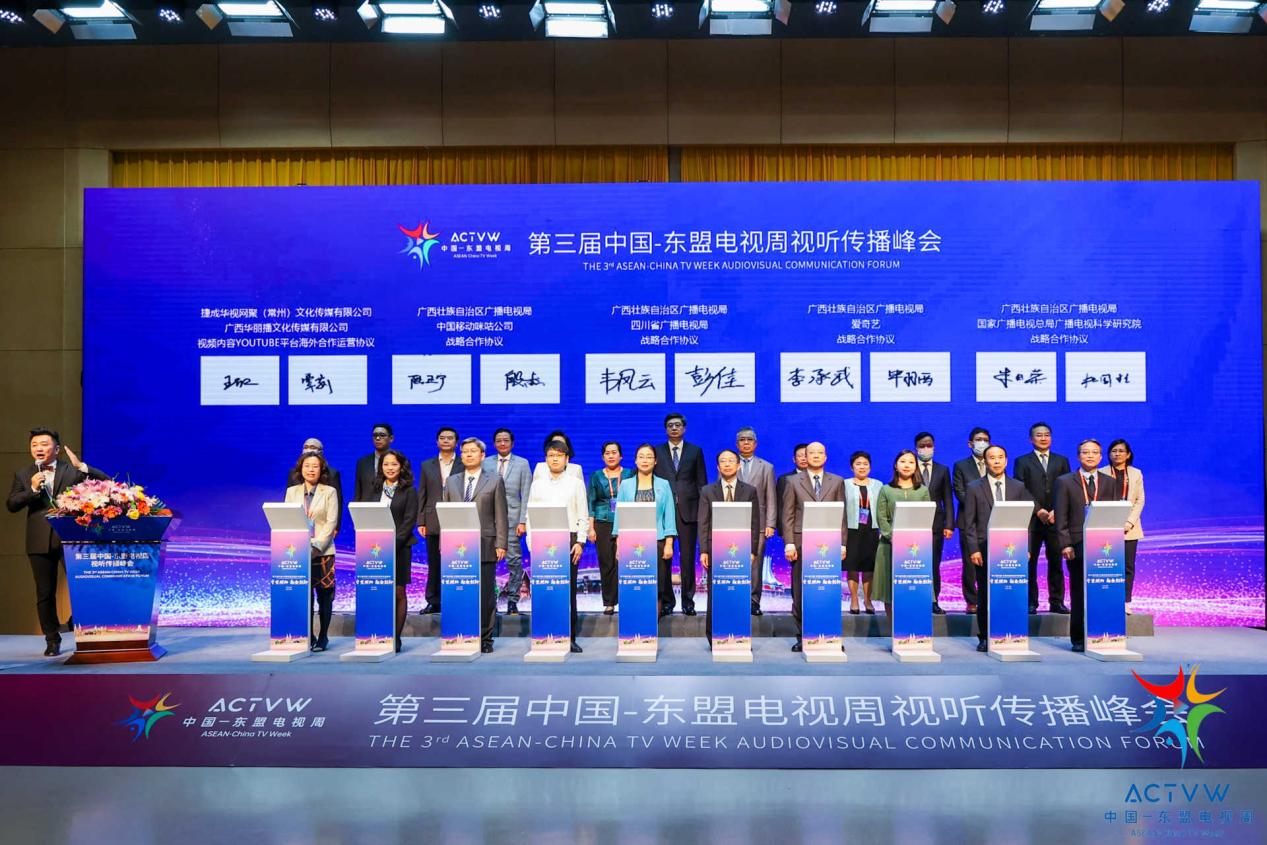

Written by Huang Yunyun / Translated by Xie Zongming
If you want to know the fastest ways to learn about a new country, watching TV series and variety shows must be the usual method. These audiovisual works are like portals that allow the audience to immerse themselves into another place and time to thoroughly experience different cultures.
In the past 20 years, Chinese audiovisual works have been imported to Southeast Asia series by series, showing a stereoscopic and comprehensive China to the ASEAN audience. China and ASEAN have started deeper cooperation in such fields as the technology and market keep innovating, which not only benefits the two sides’ economy but also brings the two peoples closer.
Learn about China in TV series
ASEAN is one of the earliest and the most important overseas markets for Chinese audiovisual works. China and ASEAN are linked by mountains and rivers and have similar cultures, for which the ASEAN audience can resonate with Chinese works. Tan Guoan, Professor of the Faculty of Art of Chulalongkorn University, who participated in the translation of the Chinese TV series Romance of the Three Kingdoms, said that Chinese TV series are easily accepted by Thai people because of the similarity in culture. Many Chinese Thai people have been influenced by traditional Chinese culture since childhood, for which Chinese culture stays in Thai society and keeps influencing the people.
Currently, Chinese audiovisual works are widely imported to all of the 10 ASEAN countries, especially in Singapore and Malaysia where the scale of imports is considerable and keeps on growing. As estimated, there are about 70 TV series, accounting for a total of more than 1,200 episodes, that are imported, translated, and dubbed into ASEAN languages and are played in the major channels in many ASEAN countries these years. While the ratio of realistic TV series is increasing, the historical costume dramas and soap operas are still the current favorites in ASEAN.
From the early exported My Fair Princess receiving fans in the ASEAN markets to the recently broadcasted realistic Chinese series May December Love 2, Ode to Joy, and Minning Town becoming popular in ASEAN, these Chinese series that carry both the cultural and economic significance have become the special “delegation” of China’s cross-cultural communications, allowing ASEAN audience to witness the development of Chinese film and television industry and Chinese society through the TV screen.

Apart from directly introducing TV series, China and ASEAN also developed an in-depth cooperation model. In 2020, China, Malaysia, and Singapore jointly filmed the remake version of the Singaporean TV series Little Nyonya. The remade series was played on China Central Television, whose viewership hit 2% in only 10 days.

Why did they choose to remake? According to Director Guo Jingyu, Nyonya culture carries both the traditional virtues of Chinese culture as well as the different cultures and customs in Southeast Asia. The Chinese audience can accept the series’ core value and still be curious about those Southeast Asian customs. How the remake was done? Guo said that they invited Ang Eng Tee and Chia Mien Yang, the scriptwriter and the director of the original series to maintain the spirit of it. Before the script adaption, Ang did special research about the Chinese audience’s preferences to adjust some of the plots while maintaining the tone of the story.
There are many more examples of such co-production. Through joint production, China shares its resources, distribution channels, and talents with ASEAN, promoting the in-depth exchange and cooperation in the film and television industry and creating a multi-dimensional, multi-channel, and diversified industry situation.
The Internet empowers audiovisual industry cooperation and development
The form and contents of China-ASEAN audiovisual cooperation are becoming richer as mobile terminals and internet technology take root in ASEAN markets. The Chinese online video platforms like iQIYI, Tencent Video, and Bilibili are trying to enter ASEAN markets after they found out the pattern for content creation and platform operation in the domestic market.
“From May 2020 to May 2021, the user number of iQIYI International in Thailand has octupled,” said Bi Yuxi, Deputy Editor-in-Chief of iQIYI, adding that Thailand, Indonesia, Malaysia, and Vietnam have become iQIYI International’s important markets. Nowadays, as the audience favors internet talent shows, iQIYI has announced the agreement on strategic cooperation with G.H.Y Culture & Media of Singapore in March 2021 to establish a management company. The project aims to seek talents in Singapore, Malaysia, Thailand, Indonesia, and the Philippines and start a new talent show, which will be exclusively on the iQIYI International. This signifies Chinese enterprises’ in-depth participation in the ASEAN entertainment industry through artist training.
Tencent Video is another influential video platform in Indonesia and Thailand. Zhang Xiaoyu, who’s in charge of the overseas region management of Tencent Video, said, “We send the quality contents outside of China and bring good contents into China as well.” She introduced that Tencent Video remakes Chinese TV series to adapt to foreign markets and puts quality overseas content on the domestic platform, creating a two-way channel for cultural communication.
On today’s internet, fragmented audiovisual forms like short videos and live streaming are contending for users’ attention from TV series and variety shows. In May 2021, the 2nd ASEAN-China “Friendship and Cooperation” Short Video Contest was held online, aiming to follow the new entertainment trend and promote people-to-people exchanges between China and ASEAN. The contest received a total of 15,686 videos from China and 10 ASEAN countries. The videos show different narratives about the cooperation against the COVID-19 pandemic and the people-to-people exchanges under different perspectives. In November 2021, Ekkaphab Phanthavong, Deputy Secretary-General of ASEAN said at the award ceremony that the success of this contest is of special significance under the pandemic. The diverse stories narrated by the younger generations show the profound friendship of the two peoples, which helps deepen the long-term cooperation between the two sides.
In the field of live streaming, young streamers from China and ASEAN countries participate in the international study for streaming and short video creation to exchange their information about rural revitalization and featured industries development.
Guangxi joins hand with ASEAN to promote sustainable audiovisual cooperation
TV series, Internet series, short videos, or live streaming are all important media products that help shape the audience’s cognition of society and the world. China-ASEAN audiovisual cooperation’s good prospects come from the joint efforts of the two sides. To grab the opportunity and guide the China-ASEAN audiovisual cooperation, the two sides have built platform mechanisms, such as the China-ASEAN Media Integration Forum, the ASEAN-China Media Cooperation Forum, and the ASEAN-China Audiovisual Communication Forum to ensure the constant improvement of their audiovisual cooperation.
In 2019, the opening ceremony of the ASEAN-China Year of Media Exchange was held in Beijing, China. In the 16th China-ASEAN Expo (CAEXPO) of 2019, the 1st ASEAN-China TV Week was officially launched as well to promote sustainable audiovisual cooperation. On October 27, 2021, the 3rd ASEAN-China TV Week, which was co-hosted by China and Laos, was held in Nanning, marking the first time that the event was co-hosted with an ASEAN country.

In that TV Week, the then Minister of China National Radio and Television Administration Zhang Hong said that the TV Week has been held 3 times and facilitated the signing of 18 cooperation agreements by the media entities either of China or between China and ASEAN countries and exhibited 442 TV programs. The TV Week also announced the Think Tank Report on China-ASEAN Audiovisual Communication, provided the experience for regional audiovisual communication and industry cooperation and development, and set a new model for China-ASEAN cultural exchanges.
Chin Uch Thy, Head of the National Television of Cambodia, said that China and Cambodia have been keeping close cooperation to promote China-ASEAN television exchange. At the TV Week, Guangxi Radio and Television signed several contracts with National Television of Cambodia, which aims to jointly film 3 documentaries respectively about the Beibu Gulf, Lancang-Mekong River, and Lijiang River to show the China-ASEAN cooperation stories and the beautiful sceneries in Guangxi.
In these years, Guangxi has conducted fruitful exchanges with the ASEAN countries since the region stimulated the vitality of Guangxi’s cultural market through improving the cultural industries management system and deepening the reform and development of cultural industry enterprises, and utilizing its regional advantages of neighboring ASEAN. By the beginning of December 2021, Guangxi has set up workstations and translation offices in ASEAN, jointly started programs like the Chinese Theatre, Chinese Anime, and Colorful China, and translated 1930 episodes of TV series and 1727 episodes of anime in total.
桂ICP备14000177号 Copyright@2006-2013 Guangxi China-ASEAN Panorama Magazine Agency Co., Ltd. All Rights Reserved